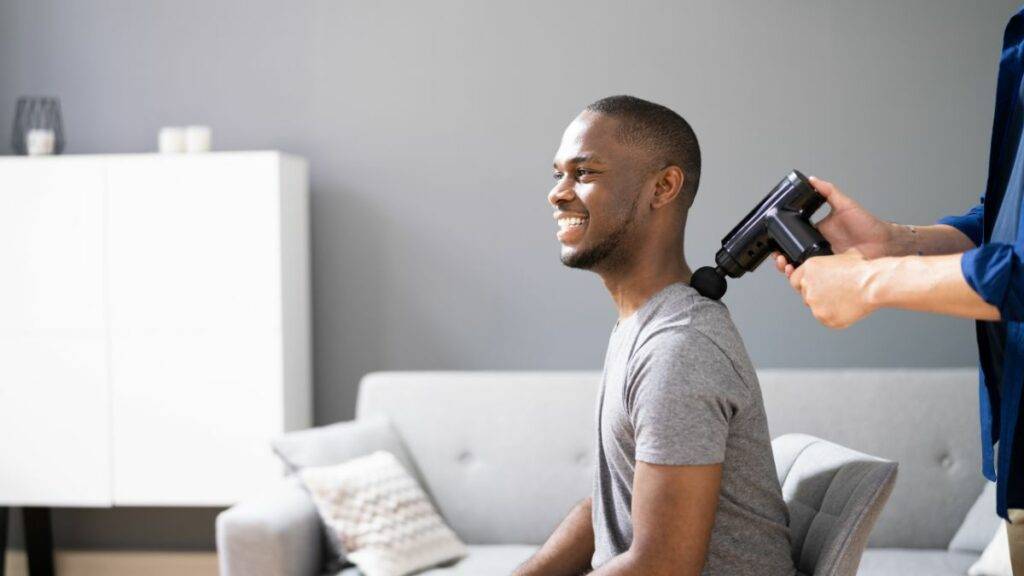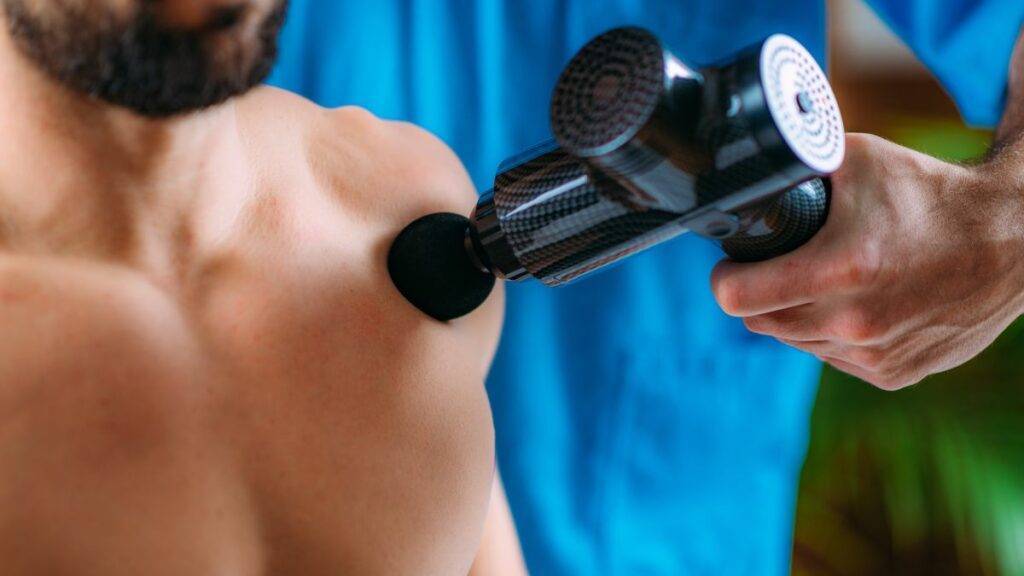It’s an all-too-familiar scenario for many fitness enthusiasts: you’ve just finished a vigorous workout and turned to your trusty massage gun for some much-needed muscle relief, only to be greeted by an uncomfortable itching sensation on your skin.
As a health professional with years of experience in physiotherapy and sports medicine, I understand the mechanics behind this reaction and the concerns it raises among users. Massage guns are designed to alleviate soreness and improve circulation through high-frequency percussion therapy – yet sometimes, they leave skin feeling more irritated than soothed.
With my background rooted in addressing muscular ailments and promoting overall well-being, I’ll unveil how something intended for relaxation can lead down a prickly path. Keep reading as we dive into why your go-to tool for recovery might have an unexpected sting; it’s simpler than you think! Discover expert insights next.
May aslo read: How to Exfoliate Your Skin Naturally?
Understanding the Causes of Itchiness Post-Massage Gun

Itchy skin after using a massage gun can be attributed to increased blood flow and inflammation, mechanical stimulation of nerves, and conditions such as pressure and vibratory urticaria.
Understanding these causes can help individuals better manage the discomfort associated with post-massage gun itchiness.
Increased Blood Flow and Inflammation
Massage guns work by hitting your muscles over and over. This may make blood rush to the area. When more blood comes, it brings nutrients and oxygen that help tired muscles heal. But this extra blood can also cause swelling in your soft tissues, which makes you feel itchy.
Sometimes, after a massage gun hits an area on your body, the place might become red and puffy. This is because of inflammation, where your body reacts to heal itself from what it thinks is injury but is really just the massage gun’s pressure.
Your nerves react to this change and might send “itchy” signals to your brain.
Mechanical Stimulation of Nerves
Nerves firing under your skin can make you feel itchy. When a massage gun hits your muscles, it shakes up the tiny nerve cells all over. These nerves send signals to your brain saying something is touching or moving against your skin.
Because of this, you might start feeling that tingling sensation just like when your foot falls asleep.
The strong vibes from the massage gun wake up these nerves even more. Imagine little electric zaps racing through under your skin; that’s what happens on a tiny level. Your body reacts by making the area itch as a way of dealing with all those busy nerve cells and sensations coming in fast and strong from being massaged.
Pressure and Vibratory Urticaria
After learning about how massage guns can tickle nerves, let’s talk about another reason skin might get itchy. Some people have a rare condition called vibratory urticaria. This means their skin can react to vibrations by getting red and itchy.
If you use a massage gun, the buzzing feeling could make this happen.
Pressure urticaria is like this too but comes from pushing on your skin for a while. When using massage guns with lots of power, they press hard and cause hives in some folks. These hives feel itchy because the body releases histamine when blood flow goes up in that spot.
Histamine is a chemical that makes your skin swell and itch when there’s an allergic reaction or other issues.
If someone has these kinds of problems after using a massage gun, they should see a doctor who knows about allergies or skins issues like dermatitis or eczema. The doctor might give medicines such as antihistamines to help with the itching and swelling or suggest creams to keep skin calm after massages.
Managing Itchiness After Using a Massage Gun

To manage itchiness after using a massage gun, it’s important to start with the lowest vibration setting and gradually increase as tolerated. Additionally, using proper technique and ensuring the duration of use is appropriate can help minimize skin irritation.
If you have sensitive skin, consulting healthcare professionals for personalized guidance and recommendations is advisable.
Starting with the Lowest Vibration Setting
Begin using the massage gun at its lowest vibration setting to help prevent itchiness. This can reduce skin irritation and allow your body to gradually get used to the stimulation.
Slowly increasing the vibration setting over time can also help avoid excessive irritation on your skin, making your massage gun experience more comfortable.
Understanding how to properly use a massage gun can greatly enhance its benefits. Gradually adjusting the settings will ensure you receive optimal relief without discomfort. Let’s delve into understanding the causes of itchiness post-massage gun next.
Using Proper Technique and Duration
To effectively manage itchiness after using a massage gun, it’s crucial to apply the proper technique and adhere to the recommended duration of use. Gently maneuver the massage gun over your skin in smooth, consistent motions to minimize friction and potential irritation.
Additionally, controlling the duration of your massage session can significantly impact its effectiveness while reducing the likelihood of skin discomfort. By practicing mindful and controlled usage, you can harness the benefits of a massage gun without experiencing unwanted itchiness or skin irritation.
Remember that utilizing the correct technique and following recommended time limits when using a massage gun is essential for optimal results and minimal discomfort. Regulating these factors can help prevent unnecessary irritation while maximizing the positive effects on muscle recovery and relaxation.
Consulting Healthcare Professionals for Sensitive Skin
If you continue to experience itchy skin after using a massage gun, consulting healthcare professionals can be beneficial. They can help identify the cause and provide appropriate treatment for sensitive skin related to managing itchiness post-massage gun use.
Vibratory urticaria may play a role in causing itchy skin, and seeking medical advice can offer insights into how to address this effectively.
Healthcare professionals can also assist in determining if there are underlying conditions contributing to the itchy skin and provide tailored strategies for relief. Their expertise ensures that individuals with all kinds of physical fitness goals receive personalized guidance to manage post-massage gun itchiness effectively, facilitating an improved overall fitness journey while maintaining healthy and comfortable skin.
Preventative Measures for Itch-Free Massage Gun Experience
To prevent itchiness after using a massage gun, it’s important to prepare your skin before the session and take care of it afterwards. Implementing proper pre-massage skincare and post-massage tips can help you achieve an itch-free experience.
Curious to learn more about how to keep your skin healthy and comfortable when using a massage gun? Keep reading for all the essential information!
Pre-Massage Skin Preparation
Before using a massage gun, it’s important to prepare your skin. Start by cleaning the skin with a gentle cleanser and then pat it dry. Apply a small amount of non-irritating moisturizer to create a smooth surface for the massage gun to glide over.
If you have sensitive skin, consider doing a patch test with the massage oil or lotion you intend to use before applying it widely on your skin. This can help identify any potential irritants and prevent adverse reactions during or after the massage.
After preparing your skin, take steps such as wearing loose-fitting clothing to ensure that the area being massaged is easily accessible. Additionally, make sure that the room is at a comfortable temperature and free of drafts so that your muscles can relax fully during the massage.
Post-Massage Skin Care Tips
After treating your skin before using a massage gun, it’s important to continue caring for your skin afterwards. Ensure that you hydrate your body by drinking water and applying moisturizer to help replenish any lost moisture during the massage.
It’s also advisable to avoid taking hot showers immediately after a massage session as they can further dehydrate the skin. Lastly, refrain from scratching any itchy areas and consider applying a cool compress if necessary to alleviate discomfort.
Also, be mindful of using gentle skincare products that are free from irritants or allergens, particularly if you have sensitive skin or a history of allergic reactions. These steps will help maintain the health and comfort of your skin post-massage therapy while supporting its recovery process.
Conclusion
In conclusion, understanding the causes of itchy skin after using a massage gun is crucial for managing and preventing this discomfort. By starting with the lowest vibration setting and using proper techniques, individuals can manage itchiness effectively.
It’s important to consider sensitivity and dryness of the skin and consult healthcare professionals if needed. These practical measures can lead to an itch-free massage gun experience, promoting better physical fitness for all users.
Additional resources on skin care could further aid in maintaining healthy skin post-massage gun use.
